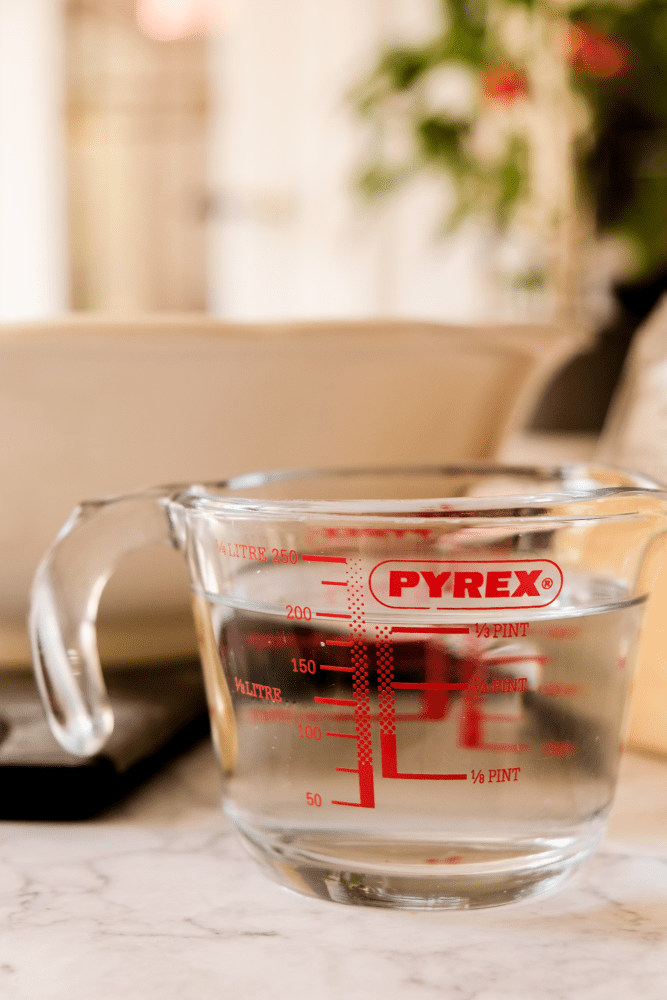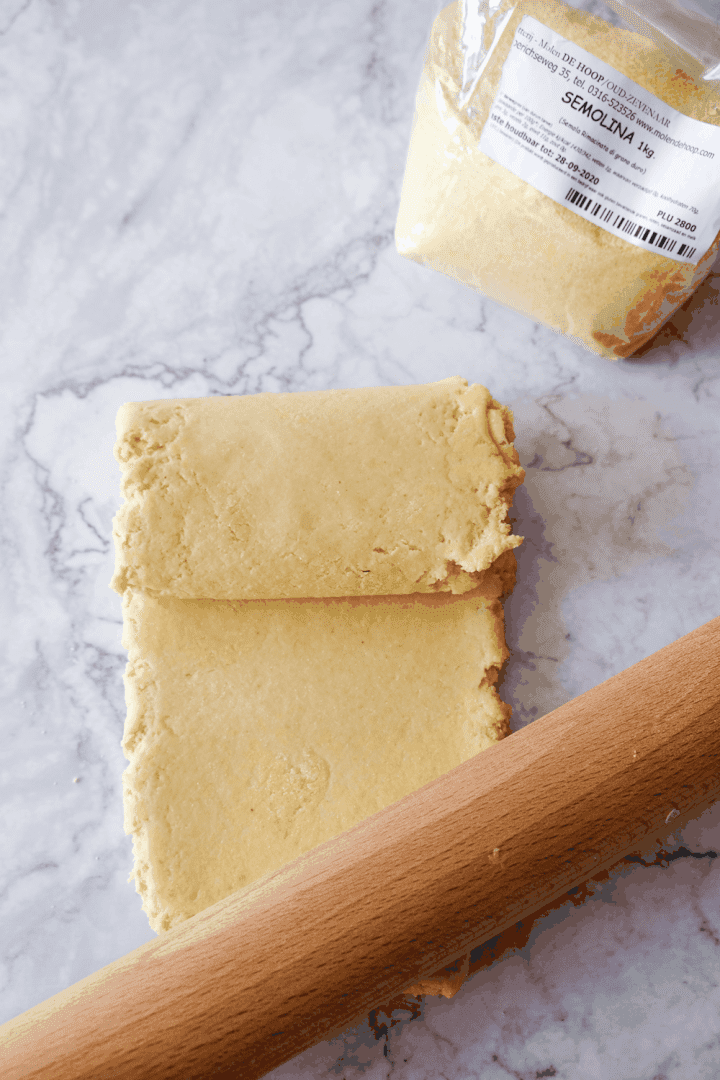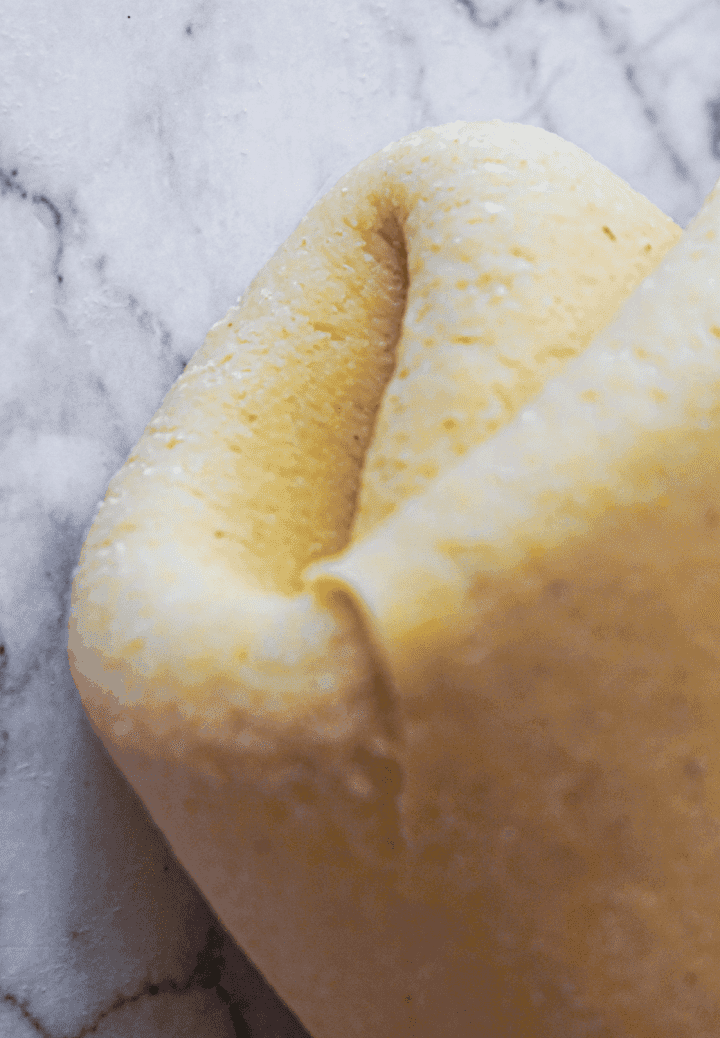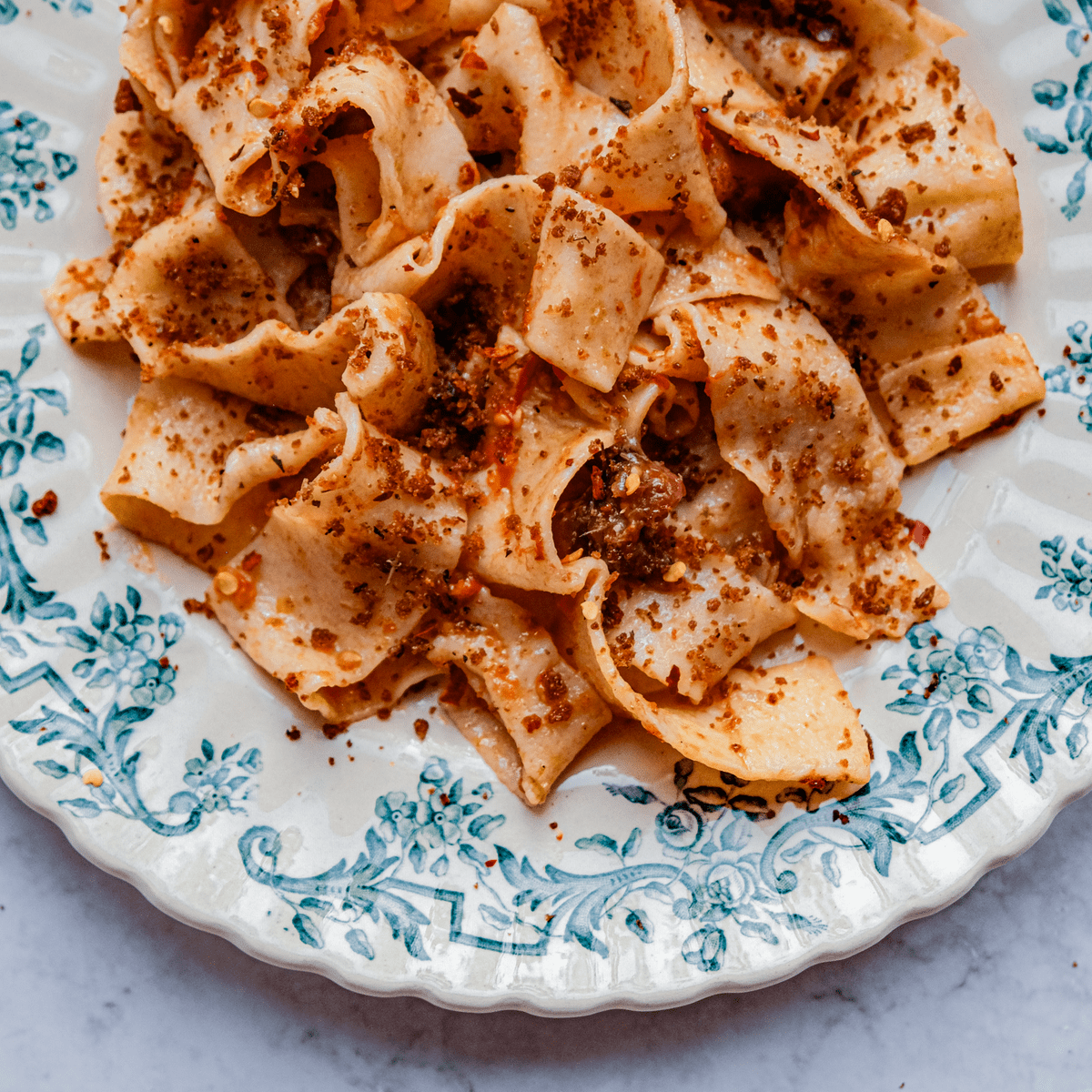
This is homemade pappardelle pasta made from nothing but fine semolina flour and water. The pasta is dressed with a very simple Sicilian-style sauce made of roasted garlic and tomatoes mixed together with very good olive oil and anchovies. It's topped at the end with a combination of toasted breadcrumbs and a few sprinkles of dried chili flakes.
Other pasta recipes:
- Handmade Macaroni
- Pillowy Soft Homemade Potato Gnocchi
- Cinnamon & Brown Sugar Pasta
- Ethiopian Lasagna
- Saffron Mac & Cheese
I often say that while I love cooking, I usually find my own cooking quite predictable. After almost 20 years of tinkering in the kitchen, I usually have an idea of what to expect when I prepare something.
Predictability in the kitchen is good I suppose, but when I make something that totally blows my taste buds away, it's all the more special. That was this dish for me.

The combination of simple ingredients and attention to detail creates an exciting taste experience. It lets the ingredients do the talking rather than the machinations of the cook. And when the ingredients do the talking, it opens a world of nuance and depth that you just can't make up.
I can't take credit for this combination. It was inspired by the recipe for Pasqualina and Maria's Tagliatelle with Tomato and Anchovy Sauce from the Official Pasta Grannies Cookbook. The dish and the grannies come from a remote little town in the south of Italy called Basilicata where a centuries old Albanian population influenced food in the area with recipes like this one, called tumact me tulez in the local dialect.
Since the combination of tomato, garlic and anchovy is typical of the Sicilian kitchen I have referred to this as 'Sicilian-style', although it should be noted that the town of Basilicata is not in the region of Sicily but in the region of Basilicata, tucked between Puglia and Calabria in the south of Italy.
The original recipe calls for some things I didn't have on hand, and so the final product is as much improvisation as it is guided. For example, the recipe calls for quite a lot of tinned whole tomatoes and tomato passata, walnuts and fresh parsley. I had none.
What I did have was a kilogram bag of semolina, a small tin of anchovies, a head of garlic, a hunk of stale bread leftover from the whole wheat braided loaf I made a few days ago, and about 20 cherry tomatoes - the first harvest from my fledgling tomato plant.

Making Homemade Pappardelle
I started by making the pasta. This was my first time making a full semolina pasta dough but with the guidance of the Pasta Grannies ratios, it turned out exactly right.
Semolina Pasta Dough Ingredients
In the Pasta Grannies cookbook they provide the golden ratio of pasta: each portion can be calculated as 45-50 grams of liquid for every 100 grams of flour. This applies to water (where 1 gram of water is equal to 1 milliliter) and to eggs - one egg being approximately 45 - 50 grams in weight.
Since I wanted to make a semolina only dough, I mixed up the following ingredients:
- 400 grams of fine semolina flour
- 180 milliliters of warm water
This is enough for 4 portions.
If you don't have a kitchen scale for weighing, as a general rule of thumb one cup of flour is about 130 grams and one tablespoon of flour is about 9 grams. So you'll need 3 cups and 2 tablespoons of flour to equal about 400 grams.


Equipment
- Kitchen scale: If you don't have a kitchen scale for weighing, as a general rule of thumb one cup of flour is about 130 grams and one tablespoon of flour is about 9 grams. So you'll need 3 cups and 2 tablespoons of flour to equal about 400 grams.
- Measuring cup with milliliter measures.
- Rolling pin.
- Pasta rolling machine: Not necessary but you can use it if you have one.
- Electric mixer (stand mixer or food processor): Not necessary but you can if you really want.
Semolina Flour vs Regular Flour
Semolina flour feels very different from regular wheat flour both in the hands and in the bite. Semolina flour is harder and feels grainier in the hands - very different from the velvety softness of wheat flour. When you're first mixing it, it feels like it will never be smooth and elastic, but it does smooth out it just takes more kneading.
You can see a really cool example of what semolina only dough can do in this video of Sardinian Filindeu pasta being pulled into hair thin strands by hand.
Likewise, since semolina flour feels harder in the hands it also gives the pasta noodles more bite. This gives you a heartier pasta with a fuller mouth feel that makes a more robust complement to flavourful sauces.
Substituting Regular Flour
If you don't have semolina flour you can substitute regular flour.
I suggest if it's possible that you replace the water with eggs if you plan to use regular wheat flour instead of semolina. This is because from my experience, flour and water only creates a dough that is very loose, springy and sticky. This makes it more difficult to work with, especially if you're a beginner making the pasta completely by hand.
If you are able to add even one egg it will help give the dough more structure. If you can't add eggs for dietary reasons or otherwise, then be sure to liberally flour the dough and your work surface and be patient. Err on the side of less water in the dough and only add more as needed - this will make the dough a bit easier to work with.
Wheat flour & egg recipe
- 400 grams of wheat flour
- 4 whole eggs
Wheat flour, egg and water recipe
- 400 grams of wheat flour
- 1 whole egg
- 135 - 150 milliliters of warm water
Wheat flour and water only recipe
- 400 grams of wheat flour
- 180 - 200 milliliters of warm water
To salt or not to salt
It's up to you whether you salt the dough or not. Usually there's plenty of salt both in the pasta water and in pasta sauce. I've done it both ways and both ways work.
Tipo-00 vs regular flour
Tipo 00 flour is commonly used in Italian preparations like pizza and pasta because it's more finely ground. The classification is unrelated to gluten content and to be honest, when I searched online I couldn't really find a good reason for why tipo-00 is better than regular flour for pasta, besides some vague references to it making the dough more tender.
From my own experience I would say that tipo-00 does improve the results for pizza dough (since it can make a more tender dough resulting in a more texturally-nuanced crust) and can improve the results for egg pasta dough (since it adds tenderness to an already structured dough) but it doesn't improve the results for wheat and water only pasta - it can actually give worse results since it makes an already loose, springy, and sticky dough much more loose, springy, and sticky.
Mixing the Dough
Semolina dough
As with any dough, I like to do the initial 'messy mixing' using a wooden spoon so I can save my clean hands for kneading. I was surprised in this case that the mixing wasn't all that messy.



The semolina flour feels very grainy, almost like sand. The water absorbs into it like a wave of water on a beach - it sinks in instead of beading on the surface as is often the case with regular flour. Mixing with a spoon does nothing but slosh the sandy mixture around so you have to use your hands.
If you're using semolina flour, the initial mixing will just get the water and flour incorporated but it will still be grainy. It took about 3 minutes of hand-kneading to get the dough to fully incorporate.
Regular wheat flour dough
If you're making a wheat flour/water or wheat flour/egg dough then the initial mixing can be done with a fork.




Hydrating the dough by rolling it out
After the initial mixing you'll need to really put your back into it so the dough can become fully hydrated i.e. the flour and liquid is perfectly homogenized. Getting the dough fully hydrated requires kneading and rest.
My preferred method to get the dough fully hydrated is to roll it out, fold on itself, and roll it out again. You can also use a pasta rolling machine for this. I have an Atlas Marcato machine but if I'm only making a small batch I like to just roll it out by hand with a rolling pin.



I did this folding and rolling probably up to 10 times, and make no mistake semolina flour is tough and hard so you'll feel it. All of this kneading helps the gluten form and gives the dough better elasticity - elasticity with structure are the basic elements for great texture. The effort is worth it.
How to know when the dough is ready
The dough is ready once it's perfectly smooth and you don't see any cracks on the edges. This applies to the semolina and egg doughs.
The wheat flour and water dough will behave a little differently - it will be ready once it has stiffened a bit and gained some structure.



Using an Electric Mixer
I've seen plenty of recipes for pasta dough where the dough is mixed either by stand mixer with dough hook attachment or by food processor.
You are welcome to go this route, but I firmly believe that with pasta as with bread the best tools are your own two hands.
Your hands are the best tools because they can feel the needs of the dough with more sensitivity than an electric mixer, and this process in turn builds up muscle memory in relation to the dough - that's how all the pasta grannies eye-ball their dough, because they know the feeling in their hands.
That being said, if you're feeling a bit lazy or tired and just want some pasta (been there) then feel free to use an electric mixer but be aware of the limitations.
stand mixer with dough hook attachment
A stand mixer is a better option than a food processor. Equipped with the dough hook attachment, you can do a lot of the heavy lifting especially when it comes to hydrating the dough fully i.e. getting the flour and liquid fully mixed.
As in the images above, semolina and egg dough is ready when the flour has been fully hydrated by the liquid and there are no more cracks on the edges of the dough. You can test this by squeezing a piece of the dough in your hands and seeing if the dough cracks.
For wheat only dough, the dough is ready when it starts to stiffen up and gains some structure - i.e. not too loose or sticky. Add more flour if it still seems too loose.
Food processor
A blade is not the most ideal tool to mix pasta dough but it is suitable enough for the initial mixing of semolina dough, wheat dough, or mixed wheat and egg dough. Gimmie Some Oven has an illustrative post on how she uses a food processor to make homemade pasta, but even in that case she kneads the dough after the initial mixing with the food processor.
Resting the Dough
Resting the dough is an important part of the process because it lets the flour fully absorb the rest of the liquid and lets the forming gluten fibres consolidate and relax, which will make both robust and loose doughs easier to work with.
Rest for at least 30 minutes wrapped tightly in a clean and lint-free kitchen cloth or a beeswax wrap if you use them. Many people use plastic wrap but I prefer not creating unnecessary waste and a kitchen cloth performs just as well.
Make ahead, freeze, or refrigerate
You can make pasta dough ahead and either freeze or refrigerate. If freezing, you will need to wait for it to defrost fully and come to room temperature.
You can also refrigerate up to 24 hours, though anymore than about 4 hours will cause the hydrated dough to oxidize and turn brown (like an apple) - it will still be good but it will be darker.
Shaping the Pappardelle Pasta
Pappardelle is a very forgiving pasta shape. After you've rested the dough, it's as simple as rolling it out to about 2-3mm thickness (either with a rolling pin or a pasta rolling machine), rolling it into a carpet, and cutting it into 2.5 cm / 1 inch strips.



Quick tips
- Be sure to liberally flour the dough before rolling it up (especially if you're using a water and flour only dough).
- When cutting the pappardelle use a sharp knife and press straight down rather than moving the knife in a sawing motion - this will create straight strips rather than jagged ones.
- Keep in mind that the pasta will swell with cooking and look slightly thicker and wider than it does in its raw form.

Cooking Homemade Pappardelle Pasta
It's best to cook the pasta once the sauce is ready.
When you are ready to cook the pasta, bring a large pot of liberally salted water to a boil. Drop the pasta in, separating it with your fingers as you do. Once it's all in the water, use a wooden spoon to mix the pasta so it doesn't stick.
Cook for 3 - 4 minutes or until the pasta is fork tender. It's a good idea to try a bite just to make sure.
Drain, reserving some of the pasta water for the sauce (and for later use if you're so inclined).
Return the pasta to the pot or a large bowl, douse liberally with good olive oil and toss to coat.
Making the Sicilian Anchovy, Tomato & Garlic Sauce with Toasted Breadcrumbs

The sauce couldn't be simpler. After you've made the dough and set it to rest, preheat the oven to 200 C / 400 F and prepare a baking dish. Toss in about 10 cherry tomatoes per portion (or an equivalent volume of whatever size tomato you can find) and one head of garlic, cut width-wise.
Cover the tomatoes and garlic with olive oil and salt (I used Herbamare seasoning salt). Roast in the preheated oven for about 25-30 minutes or until the tomatoes are burst and the garlic is caramelized. Reduce the heat if the garlic looks like it's burning.
After the tomatoes and garlic come out of the oven, mash 10 cloves of the roasted garlic with a spoonful of the tomatoes, and 6 anchovies. Add a ¼ cup of the reserved pasta water a little bit at a time until a thick paste forms. Thicken it with a good splash of olive oil - up to 2 tablespoons.


Toasted breadcrumbs: To make the toasted breadcrumbs you're going to toss breadcrumbs with olive oil in a hot skillet, watching carefully that they don't burn. You'll need about a ½ cup of breadcrumbs and a tablespoon of good olive oil for 4 portions. I also added chilli flakes and dried oregano.
I used an old hunk of stale bread for this and in the original recipe it does recommend using homemade bread. You can turn the bread into crumbs by either using a food processor or mashing it in a mortar and pestle like I did.
If you don't have any old bread kicking around, then by all means use store bough if you have it. If you don't have either store bought or homemade, then consider other crunchy toppings you can add like crushed nuts and seeds. For example, I learned from a fantastic and memorable meal in Rome at a very renowned little eatery that sesame seeds are great on pasta.

In the original recipe the breadcrumb topping also has garlic, chopped walnuts, and fresh parsley. I didn't have those things and I thought the roast garlic might soften the crumbs so my breadcrumb mix was just breadcrumbs, olive oil and chili flakes. If you do have walnuts, almonds or pine nuts and some fresh parsley or even basil those would make great additions to the breadcrumb topping.
Homemade pappardelle serving suggestion
Parmesan is wholly optional. I tried it first without the cheese and was blown away. I added cheese to see if it would really bump up the flavour, and it was good but I wouldn't say it was better.

Recipe

Homemade Pappardelle with Sicilian Anchovy & Breadcrumb Sauce
Ingredients
Pasta
- 400 grams semolina flour
- 180 ml warm water
Sauce
- 40 cherry tomatoes or equivalent volume other size tomatoes
- 4 cloves garlic
- 8 anchovy filets
- 5 tablespoons olive oil
- ½ cup breadcrumbs
- 1 teaspoon chili flakes
- 1 teaspoon dried oregano
- ½ teaspoon salt or to taste
- ½ cup pecorino or other hard cheese, for garnish
Instructions
- Preheat the oven to 200 C / 400 F.
- Mix the pasta dough: Mix the dough until incorporated and turn out onto a floured surface. Roll out with a rolling pin and fold together until the dough is fully hydrated then set it aside to rest.
- Add the tomatoes and garlic to an oven safe dish, sprinkle with olive oil and salt. Bake in the heated oven for 25 - 30 minutes until tomatoes burst and garlic softens.
- Roll out the pasta. While the tomatoes and garlic are roasting, roll out the pasta to 3mm thickness, dust liberally with flour, roll into a carpet and cut into 2.5 cm / 1 inch strips. Shake the strips loose and pile together, dusting with flour if they are sticking together. Set aside until ready to cook.
- Toss the breadcrumbs in a skillet with olive oil, chilli flakes, dried oregano, a sprinkle of salt and any additions you want to use like crushed nuts or seeds. Keep an eye so they don't burn and remove from heat as soon as they are toasted.
- Put water to boil for the pasta. Once you have a rolling boil, drop the noodles in making sure to separate them with your fingers as you do. Use a wooden spoon to stir gently and make sure they aren't sticking. Cook for about 3-4 minutes or until fork tender. Drain and cover with olive oil, reserving a ¼ cup of the pasta water.
- Once the tomatoes and garlic are ready, mash together a spoonful of the tomatoes, 10 cloves of garlic, and the anchovies adding the pasta water and a few spoons of olive oil a little at a time until a sauce forms.
- Toss the pasta in the sauce, then sprinkle in the breadcrumbs adding any fresh herbs and cheese just before serving.





Comments
No Comments